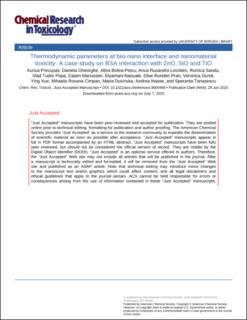| dc.contributor.author | Precupas, Aurica | |
| dc.contributor.author | Gheorghe, Daniela | |
| dc.contributor.author | Botea-Petcu, Alina | |
| dc.contributor.author | Leonties, Anca Ruxandra | |
| dc.contributor.author | Sandu, Romica | |
| dc.contributor.author | Popa, Vlad Tudor | |
| dc.contributor.author | Mariussen, Espen | |
| dc.contributor.author | El Yamani, Naouale | |
| dc.contributor.author | Rundén-Pran, Elise | |
| dc.contributor.author | Dumit, Veronica | |
| dc.contributor.author | Xue, Ying | |
| dc.contributor.author | Cimpan, Mihaela Roxana | |
| dc.contributor.author | Dusinska, Maria | |
| dc.contributor.author | Haase, Andrea | |
| dc.contributor.author | Tanasescu, Speranta | |
| dc.date.accessioned | 2021-02-02T14:12:24Z | |
| dc.date.available | 2021-02-02T14:12:24Z | |
| dc.date.created | 2020-07-06T14:00:12Z | |
| dc.date.issued | 2020 | |
| dc.identifier.citation | Chemical Research in Toxicology. 2020, 33, 2054-2071. | en_US |
| dc.identifier.issn | 0893-228X | |
| dc.identifier.uri | https://hdl.handle.net/11250/2725867 | |
| dc.description.abstract | Understanding nanomaterial (NM)–protein interactions is a key issue in defining the bioreactivity of NMs with great impact for nanosafety. In the present work, the complex phenomena occurring at the bio/nano interface were evaluated in a simple case study focusing on NM–protein binding thermodynamics and protein stability for three representative metal oxide NMs, namely, zinc oxide (ZnO; NM-110), titanium dioxide (TiO2; NM-101), and silica (SiO2; NM-203). The thermodynamic signature associated with the NM interaction with an abundant protein occurring in most cell culture media, bovine serum albumin (BSA), has been investigated by isothermal titration and differential scanning calorimetry. Circular dichroism spectroscopy offers additional information concerning adsorption-induced protein conformational changes. The BSA adsorption onto NMs is enthalpy-controlled, with the enthalpic character (favorable interaction) decreasing as follows: ZnO (NM-110) > SiO2 (NM-203) > TiO2 (NM-101). The binding of BSA is spontaneous, as revealed by the negative free energy, ΔG, for all systems. The structural stability of the protein decreased as follows: TiO2 (NM-101) > SiO2 (NM-203) > ZnO (NM-110). As protein binding may alter NM reactivity and thus the toxicity, we furthermore assessed its putative influence on DNA damage, as well as on the expression of target genes for cell death (RIPK1, FAS) and oxidative stress (SOD1, SOD2, CAT, GSTK1) in the A549 human alveolar basal epithelial cell line. The enthalpic component of the BSA–NM interaction, corroborated with BSA structural stability, matched the ranking for the biological alterations, i.e., DNA strand breaks, oxidized DNA lesions, cell-death, and antioxidant gene expression in A549 cells. The relative and total content of BSA in the protein corona was determined using mass-spectrometry-based proteomics. For the present case study, the thermodynamic parameters at bio/nano interface emerge as key descriptors for the dominant contributions determining the adsorption processes and NMs toxicological effect. | |
| dc.language.iso | eng | en_US |
| dc.title | Thermodynamic parameters at bio-nano interface and nanomaterial toxicity: A case study on BSA interaction with ZnO, SiO2 and TiO2 | en_US |
| dc.type | Peer reviewed | en_US |
| dc.type | Journal article | en_US |
| dc.description.version | acceptedVersion | en_US |
| dc.rights.holder | This document is the Accepted Manuscript version of a Published Work that appeared in final form in Chemical Research in Toxicology, copyright © American Chemical Society after peer review and technical editing by the publisher. | en_US |
| dc.source.pagenumber | 2054-2071 | en_US |
| dc.source.volume | 33 | en_US |
| dc.source.journal | Chemical Research in Toxicology | en_US |
| dc.source.issue | 8 | en_US |
| dc.identifier.doi | 10.1021/acs.chemrestox.9b00468 | |
| dc.identifier.cristin | 1818722 | |
| dc.relation.project | EC/H2020/814425 | en_US |
| dc.relation.project | EC/FP7/310584 | en_US |
| dc.relation.project | Norges forskningsråd: 288768 | en_US |
| dc.relation.project | EC/H2020/646221 | en_US |
| dc.relation.project | NILU - Norsk institutt for luftforskning: 115081 | en_US |
| dc.relation.project | NILU - Norsk institutt for luftforskning: 119044 | en_US |
| dc.relation.project | NILU - Norsk institutt for luftforskning: 119011 | en_US |
| dc.relation.project | NILU - Norsk institutt for luftforskning: 113078 | en_US |
| cristin.ispublished | true | |
| cristin.fulltext | postprint | |
| cristin.qualitycode | 1 | |
